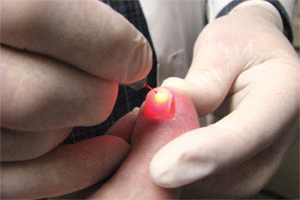What Can I Do About My Toenails?

If your toenails have changed color, lifted or become thick, you have likely developed a fungus of the toenail. A variety of health issues contribute to fungal nails including diabetes, excessive perspiration, circulatory problems or an injury to the nail bed.
Diagnosis of Fungal Nails
Our doctor will examine your nails if you are worried about an infection. The doctor may also take some nail clippings or debris from under your nail to identify the type of fungus causing the infection.
Psoriasis is a condition that can imitate a fungal infection of the nail. Yeast and other microorganisms can also infect nails. The best course of treatment for fungal nails is to first know the cause of your infection.
Symptoms
You may have nail fungus if one or more of your nails are:
- Whitish to yellow-brown discoloration
- Brittle, crumbly or ragged
- Distorted in shape
Nail fungus is common in toenails, but can also affect fingernails.
Foot Laser for Fungal Nails
Our NEW FOOT LASER is radically changing the way we treat this stubborn problem. Using a patented laser, the laser light is directed at the toe to remove the underlying infection. Patients have no discomfort during the procedure and experience no side effects. A majority of patients need only one course of treatment.
Up to now, the typical treatment for nail fungus has been a topical or oral medication. The topical medication is rarely successful in eliminating the fungus and the pills can cause very serious side effects. But with the Laser Procedure, patients now have a safe and effective way to eliminate fungal nails.













